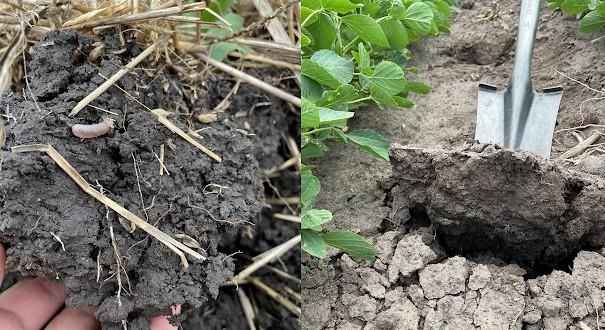By Bailey Tangen and Anna Cates

Signs of a healthy ecosystem in the field with soil health management (left), compared to signs of crusting and compaction in the plowed field (right).
Climate change is projected to change the timing, frequency, and severity of spring precipitation in Minnesota, and farmers might notice those changes first. Increases in the number and quantity of rains are expected early in the growing season in Southern Minnesota, where acres of corn and soybean dominate the landscape. Besides increasing the risk of water erosion in these fields, erratic rain patterns cause a lot of stress to farmers looking to plant corn and soybeans in May.
“Weather has always been unreliable, but the extreme weather throws us for a loop. I still remember a really wet year in the early 80s where we planted on April 28th and didn’t get wheels in the field until June 6th, because of all of the rain,” remembers Mark Ditlevson, a Steele county farmer. “There’s no set rule anymore… I suppose,” Rice county farmer Larry Salaba commented.
And though water is critical for plant growth, raindrops are destructive. Raindrops can hit the soil surface at 20 miles per hour, dislodging particles 3-5 feet into the air. The raindrops weaken the structure of the soil and pores get clogged. These pores are like the pipes in your house - if the pipe gets blocked, nothing will drain, keeping the soil waterlogged. Water flowing across the weakened soil surface carries sediment, organic matter, and excess nutrients away from fields, deteriorating the soil over time.
In the short term, farmers can’t drive equipment on wet fields, or they risk getting their tractors stuck or compacting their fields. Delaying planting can reduce yields, causing plenty of stress around rural Minnesota.
Farmers who use soil health practices such as reducing disturbance and keeping living roots in the ground are likely to increase the organic matter and stabilize the soil in their fields. When these farmers claimed that they were able to get their fieldwork done on time because they could drive on their soils more quickly after a rain than conventional neighbors, University of Minnesota researchers were eager to investigate. “We tried to understand how the soil responded to rain under different management,” said Dr. Anna Cates, Extension soil health specialist. “Were soil health practices preventing that structural breakdown as soil was saturated?”